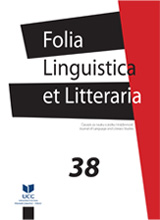Frauen und Liebesbeziehungen im Frühschaffen Dostoevskijs: Arme Leute (1845) und Der Doppelgänger (1846)
WOMEN AND ROMANTIC RELATIONSHIPS IN THE EARLY WORKS OF DOSTOEVSKY: POOR FOLK (1845) AND THE DOUBLE (1846)
Author(s): Dora KelemenSubject(s): Gender Studies, Russian Literature
Published by: Filološki fakultet, Nikšić
Keywords: Dostoevsky; women; female characters; characterization; gender; epistolary novel; Poor Folk; The Double
Summary/Abstract: This paper analyzes female characters in two early works by Fyodor Mikhailovich Dostoevsky– Poor Folk (1845, Bednye liudi) and The Double (1846, Dvoinik). It considers the literary methods used to represent those characters, as well as their relation to the male main character and some aspects of gender construction in these works. It is shown that the importance of female characters in these two works is directly connected with their (real or imagined) influence on the male main character. Consequently, a female character can play an important role in the novel even if she doesn’t personally appear in it. Women are fatal for both male characters, albeit for different reasons. Drawing on the research of Neuhäuser (1979), this article shows some further similarities in the basic structure of both works. They share the form of a love affair accompanied by intertextual references, as well as a narrated previous relationship of the male character, both of them serving as an additional explanation of the current love affair. The epistolary form of Poor Folk leads to self-representation being the main way of showing Varvara Dobroselova’s character, while Klara Olsuf’evna of The Double is depicted both from the perspective of the auctorial first-person narrator, as well as from Goliadkin’s perspective. The auctorial narrator of The Double ironizes not only Klara Olsuf’evna, but also other characters and social practices of the Petersburg society. The internal monologues and the free indirect speech of Goliadkin, however, show signs of a negative, even misogynistic attitude towards the character of Karolina Ivanovna and partially also to Klara Olsuf’evna. Lastly, Poor Folk introduces themes to Dostoevsky’s work, which occupy him until the end of his life and manifest themselves in their more recognizable form in his later works.
Journal: Folia Linguistica et Litteraria
- Issue Year: 2021
- Issue No: 38
- Page Range: 219-236
- Page Count: 18
- Language: German

